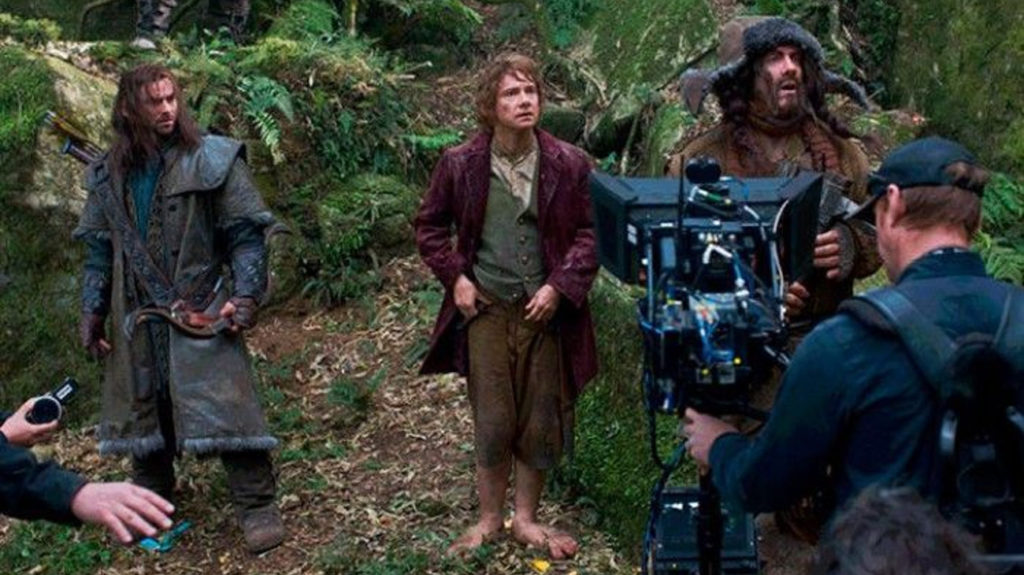The short version: 48 frames-per-second is the fucking devil.
The long version: by now, anybody who isn’t so morbidly disinterested in the matter of film technology that they have no call to be reading a filmblog in the first place, knows that The Hobbit: An Unexpected Journey is the first film to be shot in a higher framerate, twice the ordinary 24 fps that movies have been using as a standard since before there was sound; the point being that we can do that now that digital cinematography has won, and also it’s allegedly meant to make 3-D effects look more convincing and realistic, which is why good ol’ Captain 3-D himself, James Cameron, has been talking it up for the last three years.
And that, certainly, is true: I have never seen a 3-D movie look remotely as sharp and flawless and deep as An Unexpected Journey. That the film does not follow through by doing anything of particular interest with its 3-D is regrettable, but given director Peter Jackson and DP Andrew Lesnie’s history of somewhat less than effortless camerawork in their five preceding collaborations, that’s not terribly surprising. At any rate, it’s enough to keep me provisionally interested in the technology for some future application in a movie whose 3-D is a key element of its narrative function, as made by a truly bold and interrogative formalist director. Or, barring that, TRON 3.
But that is it. Outside of the unusual persuasiveness of its 3-D, the hyper-real smoothness of doubling the framerate was sheer agony to me, until the point where I got used to it; which did not, as Jackson has claimed, take 10 minutes, but closer to 90, for just about every single time I was starting to not pay attention to it, something new happened to throw it right back. After a lot of dim interiors, BOOM comes a well-lit exterior. After many slow, almost static shots with actors blocked in small, restrained movements, BOOM and they’re all running. After an hour or more of virtually no computer-generated effects to speak of, BOOM it’s an army of CGI goblins. Every shift requires an extensive recalibration, and even at the end of two hours and 49 minutes, I was never “used to” the dreadful things that 48fps does to CGI – it looks like two entirely different planes of reality, like the way that live-action/animation hybrids used to be really clumsy and “pasted-on” back in the Mary Poppins days.
The good news is that the motion sickness – yes, I actually was starting to get motion sickness from the fucking thing, something that not all the hand-held movies in all of time have ever done, and God helps us when the first shakycame 48fps film comes out – was pretty much gone by the 20-minute mark; my involuntary eye-watering lasted maybe another 10.
Besides making CGI look like it’s floating, what does 48fps do? Firstly, it gives the movement of human beings an eerie speed and smoothness that makes everything look sped-up, like a Benny Hill sketch, except nothing happens faster; they’re moving quicker at the same speed. This is unconscionably strange and difficult to process.
Secondly, it makes everything look unbelievably clear and tactile. As has been widely-reported, this has the effect of making the sets and costumes and makeup seem a bit too physical: I didn’t have the problem that many people have had where they thus seemed fake, though at times, in close-up, the makeup especially seemed off; Ian Holm, in particular, was a goddamn terror in his short opening cameo.
This increased physical reality does, however, make the movie feel less like a movie; the veil over the film, the idea that we’re watching something distant and fanciful and detached, has been removed, and not, I think, to the film’s benefit. I gather that for many people, added realism is a benefit, but in this case I absolutely hate it; I want my fantasies to have something of a mist around them. It is, however, a trait that could probably be used well elsewhere: a nature documentary, for example, where realism is the exact point of the thing. Not for nothing, the absolute best shots in the movie, where I was most grateful for the 48fps, are the landscapes, those lovely, touchable, “you are there” shots of New Zealand in all its glory.
You know what might actually be the worst thing? The lighting. By virtue of looking so very realistic and tactile and right there, right in your face, the film makes certain claims about how closely it’s going to hew to human perception. And you know what doesn’t look like the real world? Film lighting. To having something that sculpted and shaded and artificial, and have your brain screaming “this is unmediated; this is real”, is as horribly uncomfortable a perceptual gulf as anything the movie offers up.
One could, undoubtedly, get used to this; I am not sure why one would pointedly want to. For again, extra clarity and realism aren’t necessarily what I want out of my frame-rates (I still get a bit of a thrill from watching old 16fps silents, with that distinctive flickering that makes them seem so much more like movies and thus magical and special, than life). And I suppose that a lot of the problems are learning-curve problems: especially the “floating CGI” thing that never stops being a problem. One day, and perhaps as soon as the next couple of years, there might well be the film that fixes all of the problems, and harnesses this sharpness and realism in an exciting, vital new way.
But I can sure as hell name one film blogger who isn’t going to be keeping pace with the dreadful things, waiting for that moment to show up.
